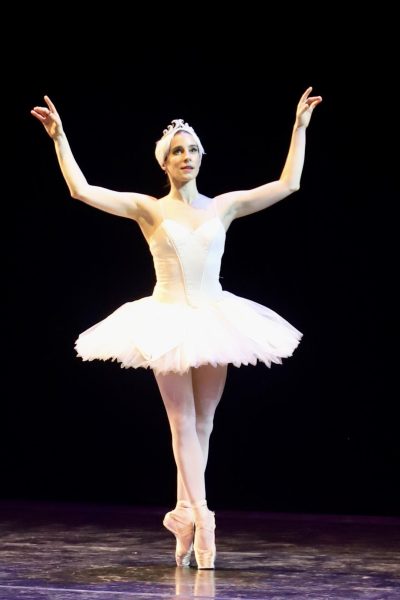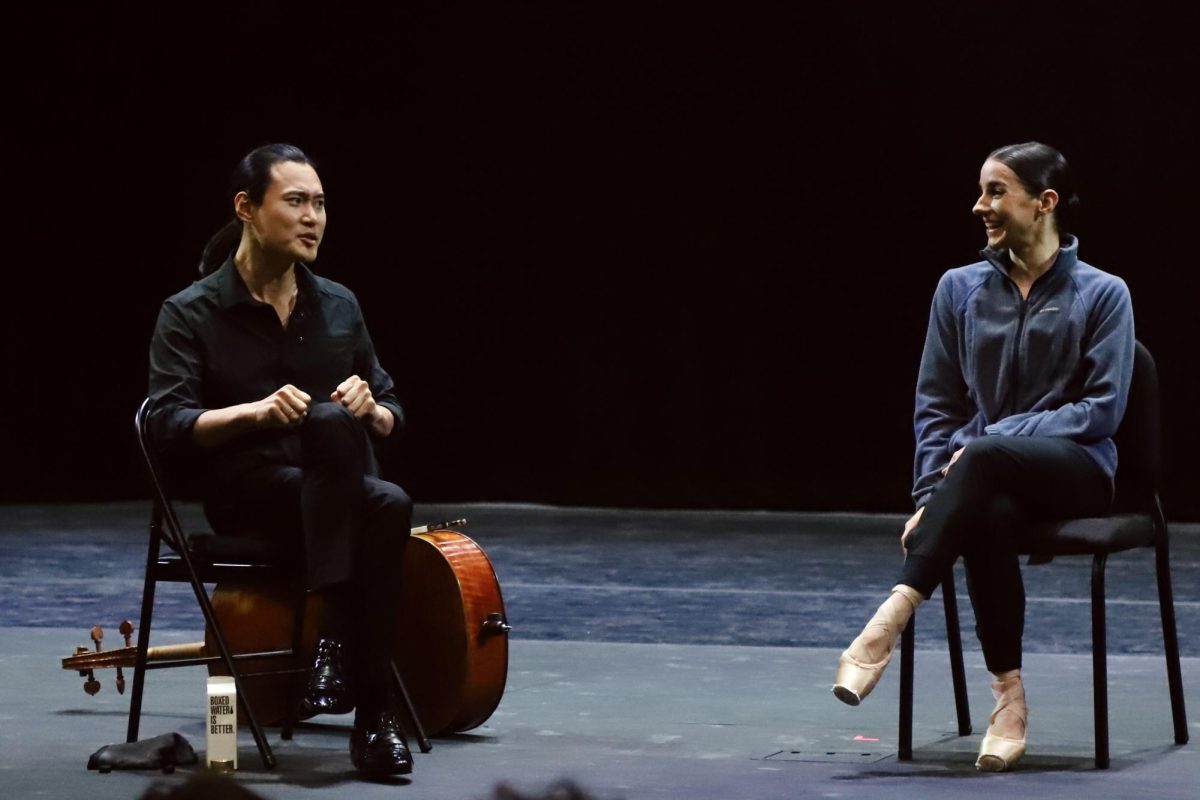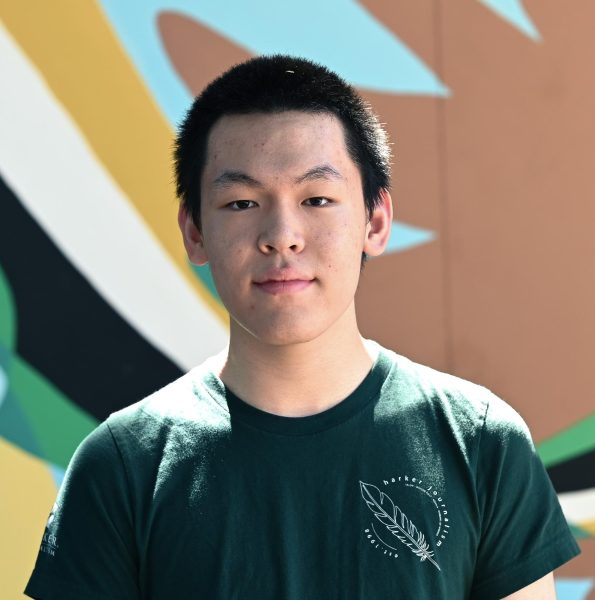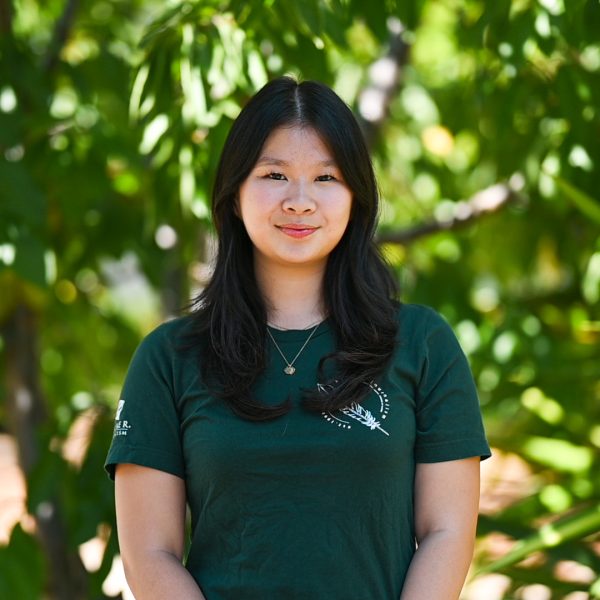The audience settles in hushed anticipation as cellist Jonah Kim draws his bow across the strings, conjuring the first note. Wearing a gray leotard and a wispy skirt, dancer Julia Rowe whirls onto the stage, mirroring the tumultuous storm resonating in the cello’s crescendo. Kim and Rowe are partners, in marriage and in art.
Grammy-winning cellist Jonah Kim and San Francisco Ballet principal dancer Julia Rowe performed for the Harker Concert Series in the Patil Theater on Nov. 3 after teaching a masterclass to students earlier that afternoon.
A South Korean native, Kim received an invitation to the Juilliard pre-college program at just seven years old. Since his debut in 2002 with the Philadelphia Orchestra, he has soloed among prestigious ensembles, from the National Symphony to the Atlantic Classical Orchestra. Kim synthesizes Italian, German, Russian and Hungarian classical genres into his own distinct school of cello.
Rowe’s journey in classical ballet commenced in Pennsylvania. After moving to California, she joined the San Francisco Ballet Company as a member of the corps de ballet in 2013 and received a promotion to be a soloist in 2016. She participated in numerous classical and contemporary ballet productions like Romeo & Juliet and Swan Lake.
Upper school instrumental music teacher Jaco Wong invited Kim and Rowe to Harker after meeting Kim at a recording studio.

“I knew that they would have a huge impact on our orchestra program.” Wong said. “They also showed how to collaborate between different disciplines and how successful that can be. They showed our students that if they work with people who have different talents than them, that they can create something really beautiful together.”
Kim and Rowe’s concert, “Songs that Make Us Dance,” featured pianist Dominic Cheli and violinist Moni Simeonov. The concert opened at 7 p.m. with Kim and Cheli playing “Viola da Gamba Sonata No. 1 in G Major” by Johann Sebastian Bach.
Next, Simeonov joined Kim for “Duo for Violin and Cello, Op. 7” by Zoltán Kodály. Cheli then returned to the stage to play alongside Kim’s “Dancing in the Eye of the Storm.” Soon, Rowe made her debut appearance of the night, performing the interpretive ballet she practiced during the masterclass.
“[Kim’s] very familiar with this piece, so he has lots of ideas and visuals that go with the music,” Rowe said. “He is telling me his ideas and I’m translating it into movement that I know as a classically trained ballet dancer. Someone who is trained in salsa, for example, might come up with something very different. I am translating this with my experiences.”
After an intermission, Kim and Rowe performed “The Dying Swan” by Mikhail Fokine to Kim’s “Le Cygne” by Camille Saint-Saëns. Kim, Cheli and Simeonov concluded the concert with “Piano Tri No. 2 in E minor, Op. 67” by Dmitri Shostakovich.
Throughout the concert, Kim’s vivid facial expressions reflected the intensity of his music, capturing an array of emotions from playfulness to panic and dismay.
“I loved hearing the folk melodies they played because I haven’t really been exposed to that before,” concert audience member Mindy Truong (10) said. “The music and the dance went well together, and Julia Rowe danced beautifully. There was also so much emotion in Kim’s facial expressions and so much clarity in his music.”
Around 70 students attended the masterclass earlier that afternoon at 3:10 p.m. on Nov. 3 in the Patil Theater. Wong first interviewed Kim and Rowe who shared insights about their disciplines and offered advice to student musicians.
“One piece of advice during the masterclass that stood out to me was to practice and also practice the right way, which was something I could work on,” attendee Sylvia Zhang (9) said. “What they said about togetherness was really impactful too.”
The duo then rehearsed their original choreography and composition “Dancing in the Eye of the Storm.” While practicing their piece, Kim and Rowe took audience feedback. They concluded the masterclass by addressing students’ questions.
Kim and Rowe strive to remind audiences that art flourishes in collaboration across cultures and disciplines.
“My teachers, growing up, always talked about how great art is made on the borders of cultures, where cultures meet and clash and fuse, yielding incredible results,” Kim said. “But I think moving forward, we can go beyond just the borders. We can explore ways that we already overlap. The only difference is how we do the same things. With art, if it’s together, it’s right.”


















![“[Building nerf blasters] became this outlet of creativity for me that hasn't been matched by anything else. The process [of] making a build complete to your desire is such a painstakingly difficult process, but I've had to learn from [the skills needed from] soldering to proper painting. There's so many different options for everything, if you think about it, it exists. The best part is [that] if it doesn't exist, you can build it yourself," Ishaan Parate said.](https://harkeraquila.com/wp-content/uploads/2022/08/DSC_8149-900x604.jpg)




![“When I came into high school, I was ready to be a follower. But DECA was a game changer for me. It helped me overcome my fear of public speaking, and it's played such a major role in who I've become today. To be able to successfully lead a chapter of 150 students, an officer team and be one of the upperclassmen I once really admired is something I'm [really] proud of,” Anvitha Tummala ('21) said.](https://harkeraquila.com/wp-content/uploads/2021/07/Screen-Shot-2021-07-25-at-9.50.05-AM-900x594.png)







![“I think getting up in the morning and having a sense of purpose [is exciting]. I think without a certain amount of drive, life is kind of obsolete and mundane, and I think having that every single day is what makes each day unique and kind of makes life exciting,” Neymika Jain (12) said.](https://harkeraquila.com/wp-content/uploads/2017/06/Screen-Shot-2017-06-03-at-4.54.16-PM.png)








![“My slogan is ‘slow feet, don’t eat, and I’m hungry.’ You need to run fast to get where you are–you aren't going to get those championships if you aren't fast,” Angel Cervantes (12) said. “I want to do well in school on my tests and in track and win championships for my team. I live by that, [and] I can do that anywhere: in the classroom or on the field.”](https://harkeraquila.com/wp-content/uploads/2018/06/DSC5146-900x601.jpg)
![“[Volleyball has] taught me how to fall correctly, and another thing it taught is that you don’t have to be the best at something to be good at it. If you just hit the ball in a smart way, then it still scores points and you’re good at it. You could be a background player and still make a much bigger impact on the team than you would think,” Anya Gert (’20) said.](https://harkeraquila.com/wp-content/uploads/2020/06/AnnaGert_JinTuan_HoHPhotoEdited-600x900.jpeg)

![“I'm not nearly there yet, but [my confidence has] definitely been getting better since I was pretty shy and timid coming into Harker my freshman year. I know that there's a lot of people that are really confident in what they do, and I really admire them. Everyone's so driven and that has really pushed me to kind of try to find my own place in high school and be more confident,” Alyssa Huang (’20) said.](https://harkeraquila.com/wp-content/uploads/2020/06/AlyssaHuang_EmilyChen_HoHPhoto-900x749.jpeg)






